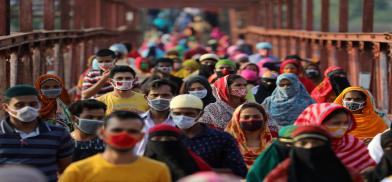With timely decision making, Bangladesh can claim success in managing COVID-19 effects
Bangladesh settled for a humanistic approach, focusing on people and their wellbeing, taking steps to minimize infection and death rates, besides ensuring the availability of food, writes Dr. Mohammad Rezaul Karim for the South Asia Monitor

COVID-19 pandemic has severely afflicted global economy, critically impacting many sectors for an indefinite period and slowing down the pace of development. Nevertheless, Bangladesh, like any other country, is trying its best to revive the economy, normalize life and sustain the environment. Dhaka, which has faced a number of disasters in the past, is utilizing these experiences to cope with the ‘Wuhan virus’ and its variants.
Accordingly, the government has launched various people-friendly initiatives to revive and streamline the economy, besides according the highest priority to healthcare. COVID-19 has already rendered 1.6 million people jobless. Those still in private sector jobs suffered hefty cuts in salaries, which impacted their living conditions. Bangladesh settled for a humanistic approach, focusing on people and their wellbeing, taking steps to minimize infection and death rates, besides ensuring the availability of food. Special packages were also announced both for the health and banking sectors. Vulnerable groups or below the poverty line were given food support.
School and colleges were shut down and a lockdown was imposed. Industrialists and company owners scaled down operations in order to minimize loss, as part of a survival strategy. The government halted or reduced funding for big projects but continued to mitigate the hardships of the poor people.
Opening up business
During the second phase, Bangladesh started easing restrictions and curfew gradually, besides allowing businesses to open. Despite reservations expressed by health experts and social activists, the government permitted the garment industry to open for the benefit of employees and the economy. Borders opened, business continued and flights resumed. When the second wave hit the country, the government imposed restrictions, but offered stimulus packages and cut interest rates to increase buying capacity and encourage investing.
During this phase, infection and death rates normalized somewhat. All economic activities, including the revival of big projects, got underway. Some even expanded to make recoveries. Good numbers were vaccinated, including those above the age of 12 years. The emphasis was also on the global partnership, online education and digital transactions.
The United Nations General Assembly also approved the Least Developed Country (LDC) graduation program during the pandemic, in view of some of the socio-economic initiatives undertaken by Dhaka. The prospect of constant uncertainty against the backdrop of emerging new Corona variants has also been a learning experience and a lesson in co-existing with the virus.
Timely decisions
The timely decision by the government for the revival of economic activities is believed to be instrumental in spurring GDP growth, managing sustainable employment, boosting export-import and, most importantly, sustaining social stability. Although initiatives for the recovery of the economy were duly funded, implementation was far from satisfactory, impinging on the well being of poorer segments.
Although the government had released a total of Taka 1,52,790 million for 14-stimulus packages in 2020 and 2021, only 60 percent could be utilized. For instance, a third of Taka 25,000 million food programme was spent in 2020, to benefit the poorer segments. However, the project of selling rice at the existing price of Taka 10 per kilo met with almost 100 per cent success. Significantly, people had the dignity to buy rice rather than get it as a dole.
The government planned to provide cash support to five million daily wagers, farmers, house staff, transport workers and teachers of technical schools and non-MPO madrasas. Each beneficiary was supposed to get Taka 2,500 as a one-time payment from a coffer of Taka 12,080 million. Sources however, pointed out that only three million people could avail of the payment in 2020. The government also continued this programme allocating Taka 8,300 million in 2021.
The incentive for health workers launched by the health ministry notched up success as Taka 1,300 million out Taka 1,380 was spent, while only Taka 910 million spent out of a corpus of Taka 7,500-million shows the poor performance.
The government should keep out an eye for newly impoverished people, creation of diversified job opportunities, development of new skills areas, control the inflation rate, mass vaccination programme to keep development going. Hence, both internal and international market mechanisms should be equally reinvigorated to partake of the broader and inclusive benefit.
(The author is a faculty member at Bangladesh Public Administration Training Centre (BPATC). Views are personal. He can be contacted at rez@bpatc.org.bd, rezapatc@gmail.com)










Post a Comment